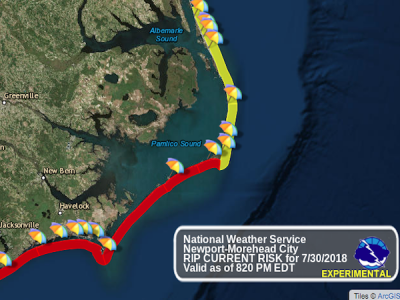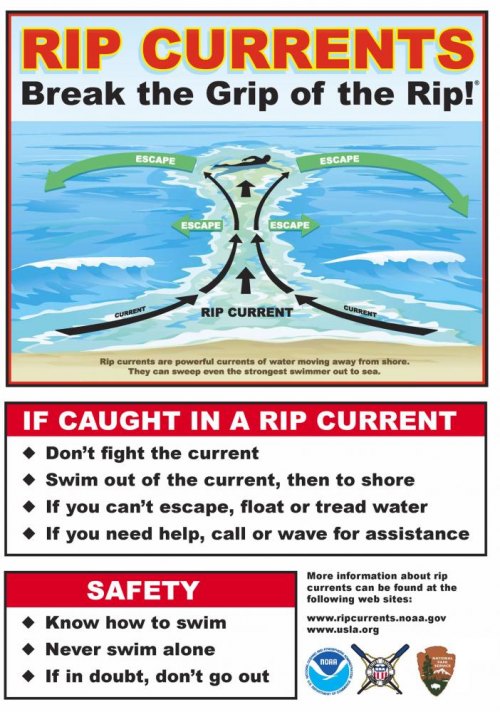Swim Safely

With all the stormy weather, Ocracoke and the Outer Banks have been experiencing higher than normal dangerous rip current activity. We're seen people asking on Facebook about where they can get good information about when and where it's safe to swim.
As of Monday, July 30th at 8:20pm, this is NOAA forecast for Tuesday, July 31st on Ocracoke:
RIP CURRENT RISK: Ocracoke...High Risk. PRECAUTIONARY/PREPAREDNESS ACTIONS... A high risk means wind, wave and tide conditions support the development of powerful or numerous rip currents along the beaches. It is recommended that you stay out of the water. All beach goers should remain aware of inherent dangers when entering the surf including strong rip currents, swift longshore currents, pounding shore break and shallow sand bars. It is safest if you swim at a guarded beach and always heed the advice of lifeguards and beach patrol.The following information is available on the Cape Hatteras National Seashore website:
The ocean is a wonderful place to swim—if you are careful. Swimming in the ocean is not the same as swimming in a pool or lake. Wind, waves, the change of the tide, the slope of the beach and other factors can cause strong currents to be present in the water even on the calmest days.
Ocean conditions can change from day to day and from hour to hour. Before going in the water, spend a few moments watching the waves. Wave patterns are a good indicator of the presence of currents and where deep water and other "surprises" are located. Know what to expect before you go in the water.
Be safe by following these tips for ocean swimming:
- When available, swim at beaches patrolled by lifeguards.
- Always swim with a buddy, and have adult supervision for children
- Know the various types of ocean currents and how to get out of them
- Use U.S. Coast Guard-approved flotation vests if a weak or non-swimmer
- Stay alert by checking the daily NOAA Rip Current Hazard Forecast, watching the weather, staying sober, and looking out for rip currents.
- Avoid swimming where danger is present: in rough seas, in inlets, around surfers, at night, or during thunderstorms
Rip Currents
Underwater sandbars often develop offshore forming a trough of water between the bar and the beach. Rip currents form when the sand bar breaks and the trapped water funnels out to the sea through the break, sometimes sweeping swimmers with it.
If you find yourself caught in a rip current, don’t swim against the current. Instead, remain calm and swim across the current, parallel to the shore, slowly working your way back to the beach at an angle. Signal for help if you need it. Learn more by exploring the WebRanger rip current activity.
Before heading to the beach, check the daily NOAA Rip Current Hazard Forecast.
Lifeguarded Beaches
There are three beach locations along Cape Hatteras National Seashore that are staffed with lifeguards during summer months from Memorial Day weekend through Labor Day, 9 am to 5 pm, seven days a week. On Ocracoke, the lifeguards are on duty at the Ocracoke Day Use Area (Lifeguard Beach)
Lifeguards can answer questions on swimming safety and weather conditions.




